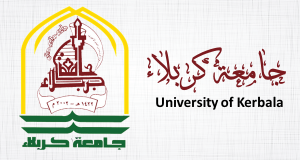Prof.Dr. Neepal Imtair Algaraawi
University of Kerbala/Faculty of education for pure science
Specialists confirm that Iraq needs to plant more than 12 billion trees at a time when its official green areas (forests) do not reach 2 percent, while the areas exposed to deterioration due to increasing desertification and bulldozing of orchards amount to more than 50 percent.
Reviving and rehabilitating forests and planting areas with these numbers of trees in the coming years could restore some of the clean air to the Iraqi atmosphere after it was polluted by harmful waste from exhausts, factories, and others.
Iraq ranks second as the most polluted country in the world in 2022, according to an annual global survey conducted by a Swiss company that manufactures air purification devices. In 2023, Iraq ranks first in the Arab world in air pollution and sixth in the world.
Reasons for the shrinkage of green spaces
The areas of forest trees have shrunk, whether in Iraq in general or in Karbala Governorate in particular, for many reasons, including unjust cutting and the conversion of lands from agricultural to residential in light of the high temperatures and strong winds laden with dirt and dust, which negatively affected the weather conditions and the lives of people in the country. The choice of tree types varies depending on the region in Iraq, which requires choosing trees according to specific types that can withstand the country’s current conditions in different regions and, at the same time, grow on little water. In this way, new forests can be formed by relying on these trees. Sahib &Algaraawi,2024).
Selection of trees
In the current article, a group of tree types was studied, which combines three characteristics:
1- It must resist high temperatures that reach 50 degrees, especially in the central and southern regions.
2- These tree types demonstrate remarkable adaptability, being tolerant to soil salinity, especially in the central and southern regions of the country. This adaptability instills confidence in their potential to thrive in diverse environments.
3- The third advantage is that it is tolerant to lack of watering, meaning it grows on little water.
Trees suitable for planting inside and outside cities (Karbala Governorate as an example)
Based on the data mentioned above and to develop strategic plans to address the problems of afforestation and forests and to revive artificial forests or green belt forests by selecting trees suitable for the climate of Karbala Governorate, a study was prepared on two groups of trees:
1- A group of trees suitable for planting outside the city
The western areas of Karbala Governorate are characterized by drought and desertification (Sahib & AlGaraawi,2024), so it is necessary to expand the green areas of the Green Belt in those areas. It also requires expansion by increasing the lands cultivated with palm forests or palm oases behind the Green Belt to increase the green areas as much as possible, in addition to their significant economic and tourism returns. This requires that the trees be tolerant to heat, salinity, and lack of watering, and the best suitable trees are:
1- Eucalyptus trees (Eucalyptus sp. )
They are considered ideal for creating green belt forests around the city, as in addition to their tolerance to high heat, salinity, and lack of watering, they can be invested in several areas, including beekeeping in their forests due to the quality of eucalyptus honey, which It is the best type of honey in the world.
2- Ghaf tree or honey mesquite, (Prosopis glandulosa)
It is considered one of the trees that tolerate drought and high temperatures, as it can remain without watering for periods. The mesquite tree is long-lived due to its tolerance to harsh climatic conditions and water scarcity. Due to its large flowers in the spring and summer seasons, apiaries can be established.
3- Palm tree oases (Pheonix sp.)
The palm tree is characterized by its tolerance to drought, salinity, and high temperatures, but its fibrous roots are not strong enough to resist strong winds. Therefore, it is preferable to plant it in oases outside the cities after the green belt and surround the perimeter of these oases with strong eucalyptus sidr, olive trees, and fruit trees that are tolerant of high-temperature conditions and groundwater salinity.
4- Sidr trees,( Ziziphus sp. )
It is a tree that is tolerant to high heat and drought. It is a perennial, evergreen, spiny, strong, branched tree that bears sweet-tasting fruits with high nutritional value. It is considered one of the distinct types of fruit. It is preferable to plant it with eucalyptus forests and palm trees.
5- Olea trees (Olea europaea )
The olive tree is an evergreen tree that can produce olives for over a century in some rare cases. It is also recommended that plants be planted in eucalyptus forests and among palm trees.
6- Pomegranate shrubs( Punica sp.)
Pomegranate trees are also considered one of the most suitable fruit trees for cultivation in saline or alkaline soils. The pomegranate tree is regarded as one of the trees highly resistant to drought.
7- Aldeflah ( Nerium sp.)
It is a multi-branched evergreen shrub that is tolerant of high temperatures and drought and can be planted with eucalyptus trees within the green belt forests around the city.
8- Fustuq halabi (Pistachio vera)
The pistachio tree is a separate, seasonal tree that lives long. It is grown in areas characterized by a hot and dry climate and tolerates salty soil. It can be grown in the desert plateau lands west of Karbala Governorate.
9- Tamarix trees
It is an evergreen tree, and its leaves can sometimes fall. The tamarisk tree grows in the harshest climatic conditions, in salty soil, and often forms dense forests. (Al-Garaawi & Hamid,2023).
2-A group of trees suitable for planting within the city
There are many trees suitable for planting within cities, in public parks, in homes, and even in departments, schools, and public facilities. Educational campaigns should be intensified for all segments of society about the dangers of global warming resulting from the decline of vegetation cover, and afforestation initiatives should be encouraged among pupils and students in schools, universities, and at home. There are many ornamental trees and fruit trees that are suitable for the environmental conditions of Karbala Governorate. We chose from them those that are fast-growing and branching and have a practical effect in reducing the impact of global warming and the risk of air and environmental pollution, including:
– All of the trees mentioned above were suggested as suitable trees outside cities are also successful for inside cities such as eucalyptus, palm trees, and others.
– Milia azedarach trees: These are significant trees due to their rapid growth and efficiency in purifying the air from pollutants.
– Acacia cloaca trees
– Egyptian acacia trees
– Acacia trees, in general
-( Cordia myxa ) tree: Ceratonia siliqua carob trees are giant evergreen trees with fruits that have economic and medicinal benefits
– (Populus) trees
– (Morus) mulberry trees
– (Delonix regia) Poinciana trees are large trees with dense flowers in bright colors that dominate most of the tree.
-(Hibiscus tiliaceus), or coastal hibiscus trees, are trees up to 10 meters tall with beautiful, heat-tolerant flowers.
– Infernal (Bougainvillea )
– Blue Jasmine (Jasminum glaucoma) is a fast-growing, evergreen climber
– Indian Jasmine (Plumeria alba), large trees with beautiful flowers
– Elias (Myrtus communis)
– Citrus trees
– The palm of Mary (Vitex agnus-castus)
– (Callistemon viminalis) hero brush
Pomegranate shrubs( Punica sp.) Eucalyptus trees (Eucalyptus sp. )
Sidr trees,( Ziziphus sp. ) Olea trees (Olea europaea )
Fadak palm farms in Karbala Aldeflah ( Nerium sp.)
Ghaf tree, (Prosopis glandulosa) Fustuq halabi (Pistachio vera)
Acacia cloaca trees Milia azedarach trees
(Delonix regia) poinciana Infernal Bougainvillea
(Hibiscus tiliaceus), or coastal hibiscus (Callistemon viminalis) hero brush
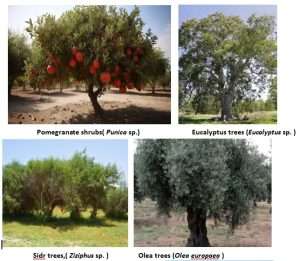
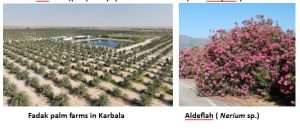
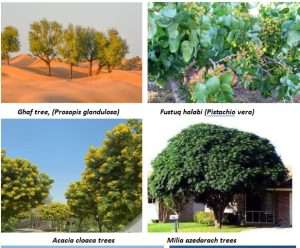
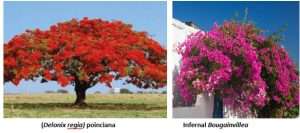
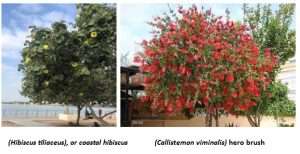
References
– Taher H.S., Algaraawi,N.I. and AlArdawi,K.G. Survey study to four families of Dicotyledon in Ain Al-tamur district.. Samarra J. Pure Appl. Sci., 2022; 4 (4): 109-122.
– Al-Garaawi,N.I. Hamid,B.A.. A Survey Study of Wild Plants in AL Al Najaf Desert .International Journal of Aquatic Science. Vol 14, Issue 01, 2023.
– Sahib, H. A., & AlGaraawi, N. I. (2024). A survey study of the plants of Al Hur District in the Holy City of Karbala. International Journal of Health Sciences, 8(S1), 612–637. Retrieved fromhttps://sciencescholar.us/journal/index.php/ijhs/article/view/14871.
– Sahib, H. A., & AlGaraawi, N. I. (2024). A survey study of the plants of the district center of Holy City of Kerbala. International Journal of Health Sciences, 8(S1), 593–611. Retrieved from https://sciencescholar.us/journal/index.php/ijhs/article/view/14870


